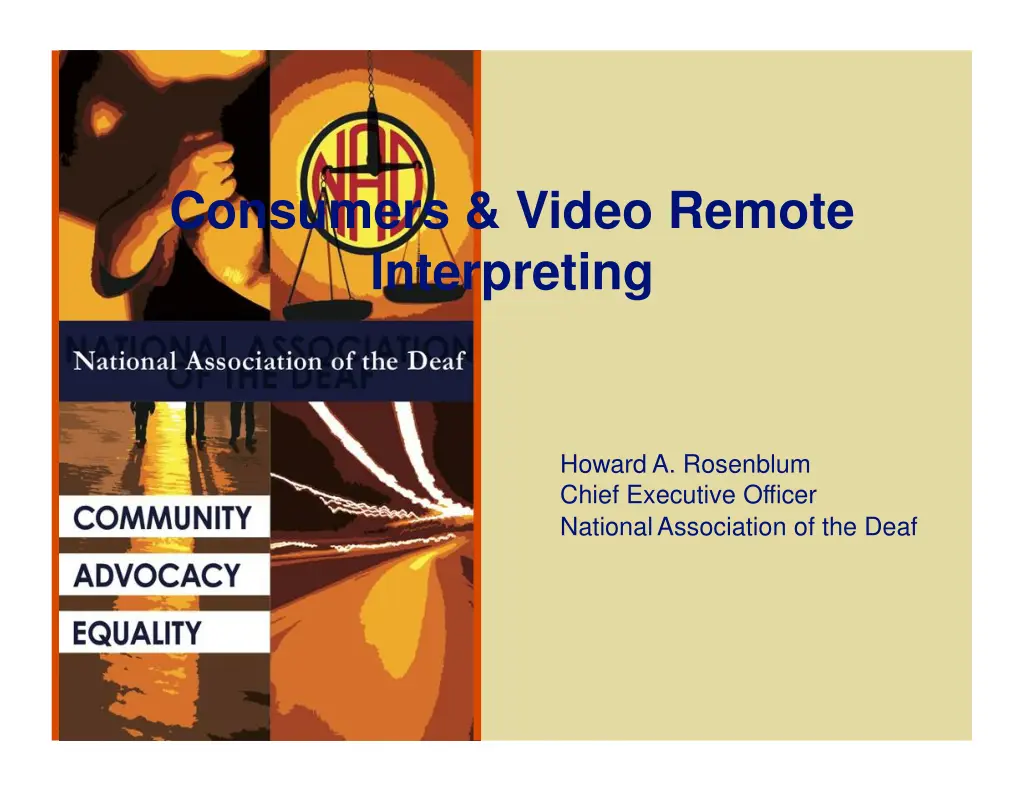
Understanding Video Remote Interpreting for Consumers
Learn about the legal mandates, regulatory requirements, and consumers' concerns related to Video Remote Interpreting (VRI), including the Americans with Disabilities Act, minimum VRI service standards, and factors affecting consumers' perception of VRI services.
Download Presentation

Please find below an Image/Link to download the presentation.
The content on the website is provided AS IS for your information and personal use only. It may not be sold, licensed, or shared on other websites without obtaining consent from the author. If you encounter any issues during the download, it is possible that the publisher has removed the file from their server.
You are allowed to download the files provided on this website for personal or commercial use, subject to the condition that they are used lawfully. All files are the property of their respective owners.
The content on the website is provided AS IS for your information and personal use only. It may not be sold, licensed, or shared on other websites without obtaining consent from the author.
E N D
Presentation Transcript
Consumers & Video Remote Interpreting HowardA. Rosenblum Chief Executive Officer NationalAssociation of the Deaf
Consumers view of VRI Legal Mandate Regulatory Requirements Consumer Concerns Best Practices
Legal Mandate Americans with DisabilitiesAct Title I: Employers (w/ 15+ employees) must provide reasonable accommodations including interpreters Titles II & III: Medical, legal & educational service providers must provide auxiliary aids and services to ensure effective communication
Regulatory Requirements AuxiliaryAids & Services include: Qualified interpreters on-site or through video remote interpreting (VRI) services (28 CFR 35.104, 36.104) Qualified interpreter definition includes on- site and VRI (28 CFR 35.
Regulatory Requirements VRI service minimum standards: (1) Real-time, full-motion video and audio over a dedicated high-speed, wide bandwidth video connection or wireless connection that delivers high- quality video images that do not produce lags, choppy, blurry, or grainy images, or irregular pauses in communication (28 CFR 35.160(d)(1))
Regulatory Requirements (2) A sharply delineated image that is large enough to display the interpreter s face, arms, hands and fingers, and the participating individual s face, arms, hands and fingers, regardless of his or her body position (28 CFR 35.160(d)(2))
Regulatory Requirements (3) A clear, audible transmission of voices; and (4) Adequate training to users of the technology and other involved individuals so that they may quickly and efficiently set up and operate the VRI (28 CFR 35.160(d)(3) & (4))
Consumers Concerns 2-Dimensional versus 3-Dimensional Positioning of VRI Reliability of technology Ability of tech staff to operate VRI Quality of interpreters, including regional signs & use of specialized vocabulary
Best Practices Options VRI not optimal for all situations On-site interpreters as an option VRI as one option, possibly as temporary measure such as in medical Need to be prepared to address all VRI technological and personnel challenges
Best Practices Options Need to be prepared to address all VRI technological and personnel challenges (including back up equipment and 24/7 staff) Need to ensure quality of interpreters match specialized language and regional signs
